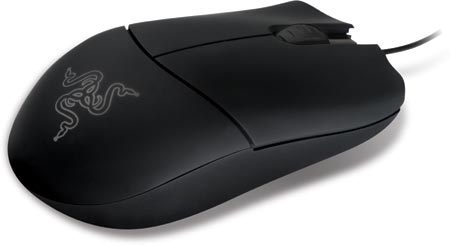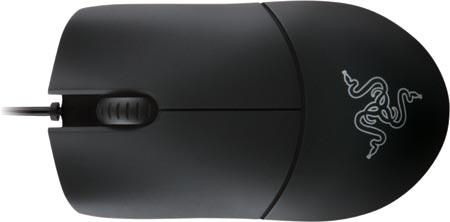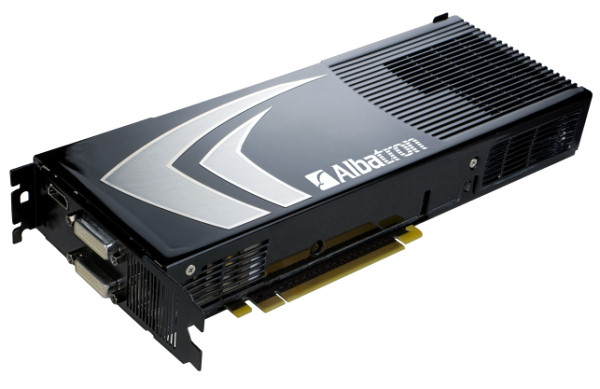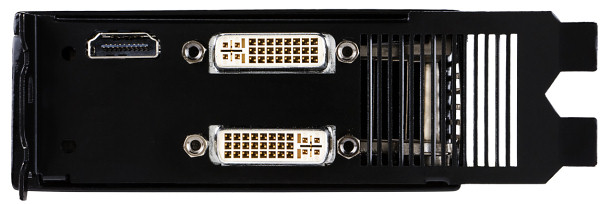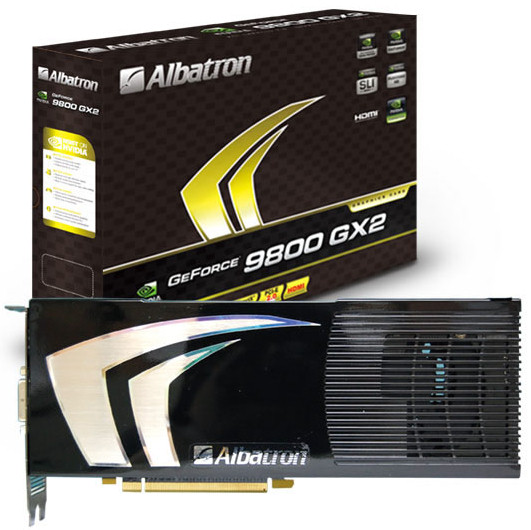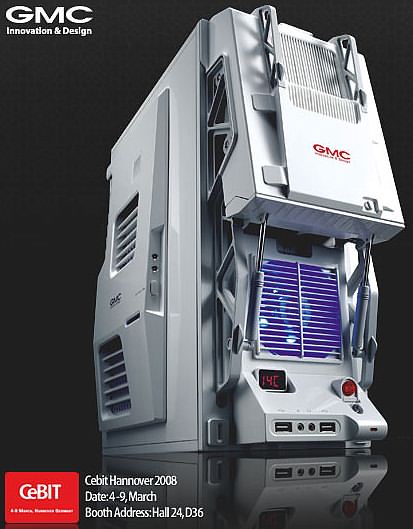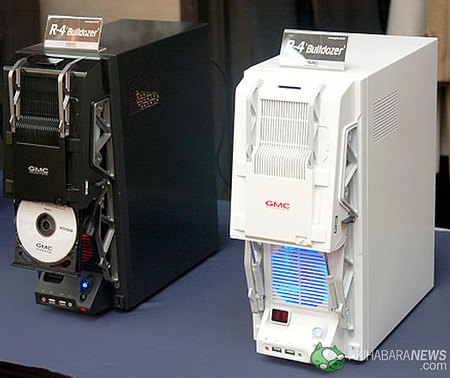Intel Announces Intel Atom Brand for New Family of Low-Power Processors
Razer Showcases Entry-Level Salmosa Mouse
Photos of Albatron 9800GX2-1GX
GMC Showcases R-4 Bulldozer at CeBIT 2008
RightMark CPU Clock Utility 2.35 Released
RightMark Memory Analyzer 3.8 Released
Intel Announces Intel Atom Brand for New Family of Low-Power Processors
The Intel Atom processor will be the name for a new family of low-power processors designed specifically for mobile Internet devices (MIDs) and a new class of simple and affordable Internet-centric computers arriving later this year. Together, these new market segments represent a significant new opportunity to grow the overall market for Intel silicon, using the Intel Atom processor as the foundation. The company also announced the Intel Centrino Atom processor technology brand for MID platforms, consisting of multiple chips that enable the best Internet experience in a pocketable device.
 |
 |
The Intel Atom processor is based on an entirely new microarchitecture designed specifically for small devices and low power, while maintaining the Intel Core 2 Duo instruction set compatibility consumers are accustomed to when using a standard PC and the Internet. The design also includes support for multiple threads for better performance and increased system responsiveness. All of this on a chip that measures less than 25 mm², making it Intel's smallest and lowest power processor yet. Up to 11 Intel Atom processor die—the tiny slivers of silicon packed with 47 million transistors each—would fit in an area the size of an American penny.
These new chips, previously codenamed Silverthorne and Diamondville, will be manufactured on Intel's industry-leading 45nm process with hi-k metal gate technology. The chips have a thermal design power (TDP) specification in 0.6-2.5 watt range and scale to 1.8GHz speeds depending on customer need. By comparison, today's mainstream mobile Core 2 Duo processors have a TDP in the 35-watt range.
Formerly codenamed "Menlow," Intel Centrino Atom processor technology includes the Intel Atom processor, a low-power companion chip with integrated graphics, a wireless radio, and thinner and lighter designs.
Source: Intel
Razer Showcases Entry-Level Salmosa Mouse
At CeBIT 2008 Razer is showcasing its first entry-level mouse named Salmosa.
Specifications:
- 1800dpi Razer Precision 3G infrared sensor
- 1000Hz Ultrapolling / 1ms response time
- Mechanical dpi/polling rate switches
- On-The-Fly Sensitivity adjustment
- Always-On mode
- Ultra-large non-slip buttons
- 16-bit ultra-wide data path
- 60-120 inches per second
- Three independently programmable Hyperesponse buttons
- Ambidextrous design
- Scroll wheel with 24 individual click positions
- Zero-acoustic Ultraslick Teflon feet
- Seven-foot, lightweight, non-tangle cord
- Approximate size: 115mm (length) x 63mm (width) x 37mm (height)
Razer claims Salmosa to be the lightest input device in its class. The novelty is aimed at gaming enthusiasts. Razer Salmosa will go on sale worldwide in Q3'08. In U.S. it will cost $40, in Europe—€30.
Source: Razer Salmosa
Photos of Albatron 9800GX2-1GX
As the title says, just the photos this time.
Source: Albatron
GMC Showcases R-4 Bulldozer at CeBIT 2008
At CeBIT 2008 South Korean GMC is showcasing original PC enclosures named 'R-4 Bulldozer' accordignly to the looks.
While there's no information on the company's website, it's clear that R-4 is more catchy than GMC R2 TOAST.
RightMark CPU Clock Utility 2.35 Released
The RightMark team released a new version of the RightMark CPU Clock Utility.
Changelog:
- Added automatic SuperLFM feature detection (Intel Santa Rosa platform).
- Corrected main tray icon animation to include SuperLFM state.
- Added identification of 45nm Intel Core 2 CPUs.
- Added identification of Intel Celeron Dual Core CPUs.
- Fixed performance on demand state comparison in SuperLFM mode.
- Corrected CPU load measurement in SuperLFM state (Intel Santa Rosa platform).
- Performance on Demand profiles now shouldn't get stuck in SuperLFM state.
- CPU defaults settings now use P-states rather than FID/VID pairs.
- P-states table disabled when CPU power management features are unavailable.
- RMClock PRO: "Application running" event now also includes processes from other users.
- Added preliminary support for 45 nm Intel Core 2 family processors (Yorkfield, Wolfdale and Penryn cores).
- Fixed Auto-adjust intermediate states VIDs feature behavior on Intel Santa Rosa platform.
- Added flexible VID choice for Intel Dynamic Acceleration (IDA) P-state.
- Modified FID/VID range used in Monitoring.
- Fixed CPU frequency measurement in SuperLFM mode.
- Reverted not to use 8254 timer by default as a clock source for CPU frequency measurement.
- Added preliminary detection and support for Intel Dynamic Acceleration (IDA) and Dynamic FSB Frequency Switching (DFFS) technologies on Intel Santa Rosa platform.
- Changed minimal VID and Maximal FID/VID detection on Intel Core 2 CPUs.
- Redesigned CPU performance states editor (Profiles page) to indicate P-state type and support flexible FID P-states.
- Modified default settings of custom Vista OSPM plan to automatically disable the OS CPU power management.
- Removed "Use Intel Core 2 ACNT for the CPU load determination" registry tweak.
- Implemented 4-digit VID fraction indication in most UI parts.
- Improved design of the Settings page.
- Restricted application language selection to the available resource DLLs only.
- Added use of 8254 timer as a clock source for CPU frequency measurement by default (configurable via registry tweak).
- Added support for Intel ICH9DO southbridge.
- Added new multiprocessor platforms CPU load calculation methods.
- Added detection of AMD Family 10h Opteron CPUs (no support for AMD Cool`n'Quiet 2 technology yet).
- RMClock Updater: added update version restrictions to prevent the download and installation of incorrect update versions.
- Added detection of the mobile Intel Core 2 Solo processors.
- Added support for the new Intel Core 2 family processors (CPUID 10661h).
- Fixed OSPM settings names display on localized Windows versions.
- Fixed log file handling.
The new version is available here.
Source: CPU.RightMark.org
RightMark Memory Analyzer 3.8 Released
The RightMark team released a new version of the RightMark Memory Analyzer.
Changelog:
- RightMark Memory Stability Test (RMMS) component updated to version 1.2: improved memory allocation scheme now allows testing up to 2000MB of memory at once, if available; added log file time stamp.
- RightMark Multi-Threaded Memory Test (RMMT) component updated to version 1.1: added individual threads selection to the "All Threads" group, improved "Lock Virtual Memory Pages" feature behavior.
- Added EPP/XMP info to the RMMA System Info report.
- Added support for DDR3 SPD and Intel XMP (eXtreme Memory Profiles) SPD extension.
- Added limited support for Intel 3 series chipsets (Memory SPD reading).
- Added identification of several AMD Athlon 64 X2 NPT (revision F) CPU cores.
- Added identification of new Intel Core 2 CPUs, including 45nm cores.
- New CPU Database entries.
The new version is available here.
Source: CPU.RightMark.org
Write a comment below. No registration needed!


